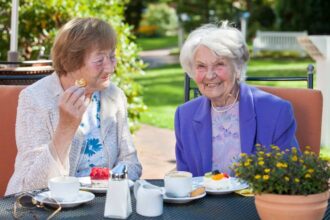There is no doubt that COVID-19 has impacted the way that our aged care homes operate in Australia. Our dietitians have observed numerous homes step up to the plate and modify their dining rooms to provide safe dining experiences for their residents. Some homes are no longer using their dining rooms, while others are implementing strategies to allow for the social distancing.
Importance of the dining environment
The dining environment influences residents’ enjoyment of their food. A welcoming, home-like dining room is known to have a positive impact on resident’s oral intake – conversely, a poor dining experience can deter oral intake.
Social isolation is a contributing factor to malnutrition amongst older people.1 Sharing meals with other residents in the dining room provides the opportunity for positive social interaction and mirroring of eating habits – both of which may assist in improving oral intake.
Changes to dining rooms during COVID-19
As per advice from the Department of Health, your home can continue to have gatherings of residents in communal areas – including the dining room, as long as residents are free of COVID-19 symptoms. They must adhere to physical distancing and current jurisdictional requirements for gathering sizes – but this does not mean that your home needs to close the doors on dining rooms altogether.
Supporting our residents
Your home needs to continue providing good quality care for their residents meanwhile implementing COVID-19 safe practices.
Here are simple strategies you can implement:
- Adapt dining room seating arrangements and table settings to allow for social interactions while following physical distancing guidelines.
- If the home is restricting movement of residents from their rooms, consider positioning residents in their room doorways with tables for meals.
- Eating outdoors may be an option for homes who have smaller dining rooms which do not facilitate social distancing. Outdoor settings can change the routine and provide a chance for residents to get sunlight exposure for Vitamin D.
- Encourage families to share a meal with residents who are isolated in rooms via video calling (i.e. Facetime, Zoom, Skype).
- Implement ‘protected mealtimes’. Minimise all clinical activities during mealtimes, including medication rounds.
- Proactively engage with your dietitian and medical practitioners regarding any residents considered at risk of malnutrition.



